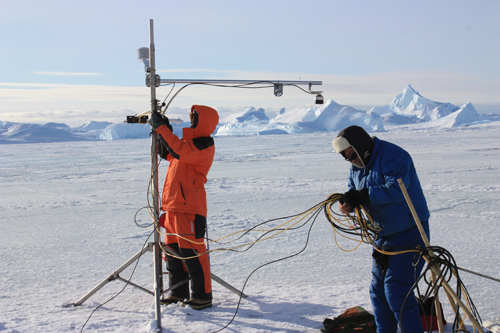Two-year In-situ Albedo over Landfast Sea Ice in Antarctica
Date:2015-12-16
In contrast to the rapid decline of Arctic sea ice, Antarctic sea ice has increased since the beginning of the satellite observation age (e.g., Liu et al., 2010). To understand the variations of Antarctic sea-ice albedo and its influence on sea ice and evaluate the performance of current sea-ice albedo parameterizations used in climate models, The in-situ albedo has been continuously monitored over Antarctic coastal landfast sea ice in Prydz Bay, near Zhongshan Station, since 2010, through the collaboration of the National Marine Environmental Forecasting Center of China and the State Key Laboratory of Numerical Modeling for Atmospheric Sciences and Geophysical Fluid Dynamics, Institute of Atmospheric Physics, Chinese Academy of Sciences.

Scientists setting up a net radiometer over the landfast sea ice near Zhongshan Station. (Photo courtesy: Jiechen Zhao)
In a paper accepted for publication in Advances in Atmospheric Sciences (Yang et al., 2016), Chinese, German and Finland scientists demonstrate that the measured albedo varied from 0.94 over thick fresh snow to 0.36 over melting sea ice during austral spring and early summer of 2010 and 2011. Snow thickness was the most important factor influencing the albedo variation, followed by synoptic events and overcast skies. They further found that the parameterized albedo has significantly different albedo evolutions compared to the observation, particularly during the melting period. This is in general consistent with a previous study for Arctic sea ice (Liu et al., 2007).
After analyzing the measured albedo, a modified albedo parameterization was developed based on the parameterization used in the NCAR coupled climate model. By further considering the effects of synoptic events, cloud cover, as well as the local landfast sea-ice surface characteristics, the modified parameterization effectively captured the observed variations in the albedo. However, it should be noted that further evaluations with more field observations over Antarctic sea ice are still needed.
References
Yang, Q., J. Liu, M. Lepparanta, and Coauthors, 2016:
Liu, J. P., Z. Zhang, J. Inoue, and R. M. Horton, 2007:
Liu, J. P., and J. A. Curry, 2010:
Contact:
Dr. LIU Jiping, jliu@lasg.iap.ac.cn
